Learning the friendly way
Dive into our resources, guides, and articles for all things money-related. Grow your financial confidence with our experts curated tips and articles for both experienced and new investors.
LATEST ARTICLEs

The crypto market just pulled off one of its boldest recoveries in recent memory. What began as a violent sell-off on October 10 has given way to a surprisingly strong rebound. In this piece, we’ll dig into “The Great Recovery” of the crypto market, how Bitcoin’s resilience particularly stands out in this comeback, and what to expect next…
The Crash That Shook It All
On October 10, markets were rattled across the board. Bitcoin fell from around $122,000 down to near $109,000 in a matter of hours. Ethereum dropped into the $3,600 to $3,700 range. The sudden collapse triggered massive liquidations, nearly $19 billion across assets, with $16.7B in long positions wiped out.
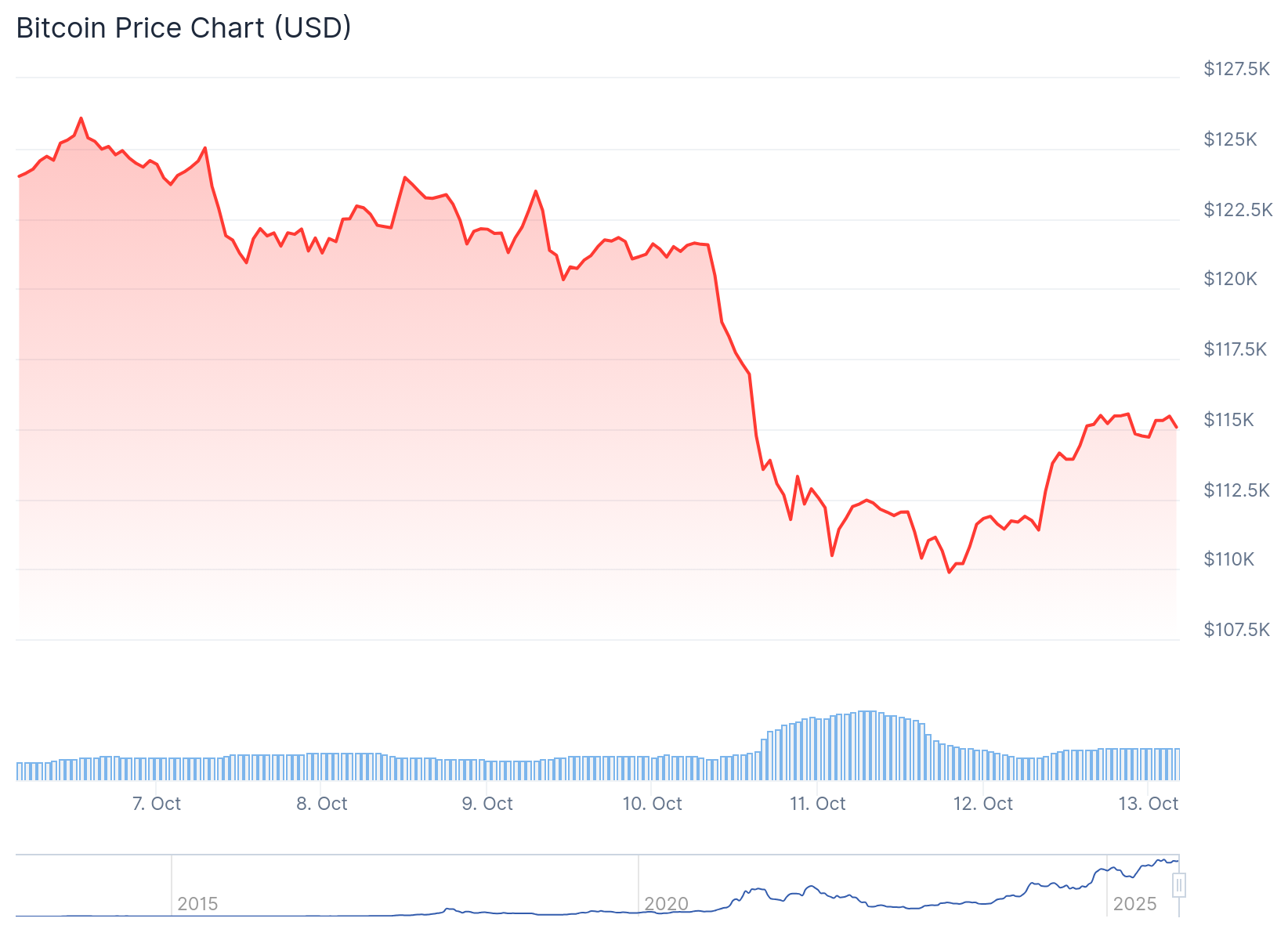
That kind of forced selling, often magnified by leverage and thin liquidity, created a sharp vacuum. Some call it a “flash crash”; an overreaction to geopolitical news, margin stress, and cascading liquidations.
What’s remarkable, however, is how quickly the market recovered.
The Great Recovery: Scope and Speed
Within days, many major cryptocurrencies recouped large parts of their losses. Bitcoin climbed back above $115,000, and Ethereum surged more than 8%, reclaiming the $4,100 level and beyond. Altcoins like Cardano and Dogecoin led some of the strongest rebounds.
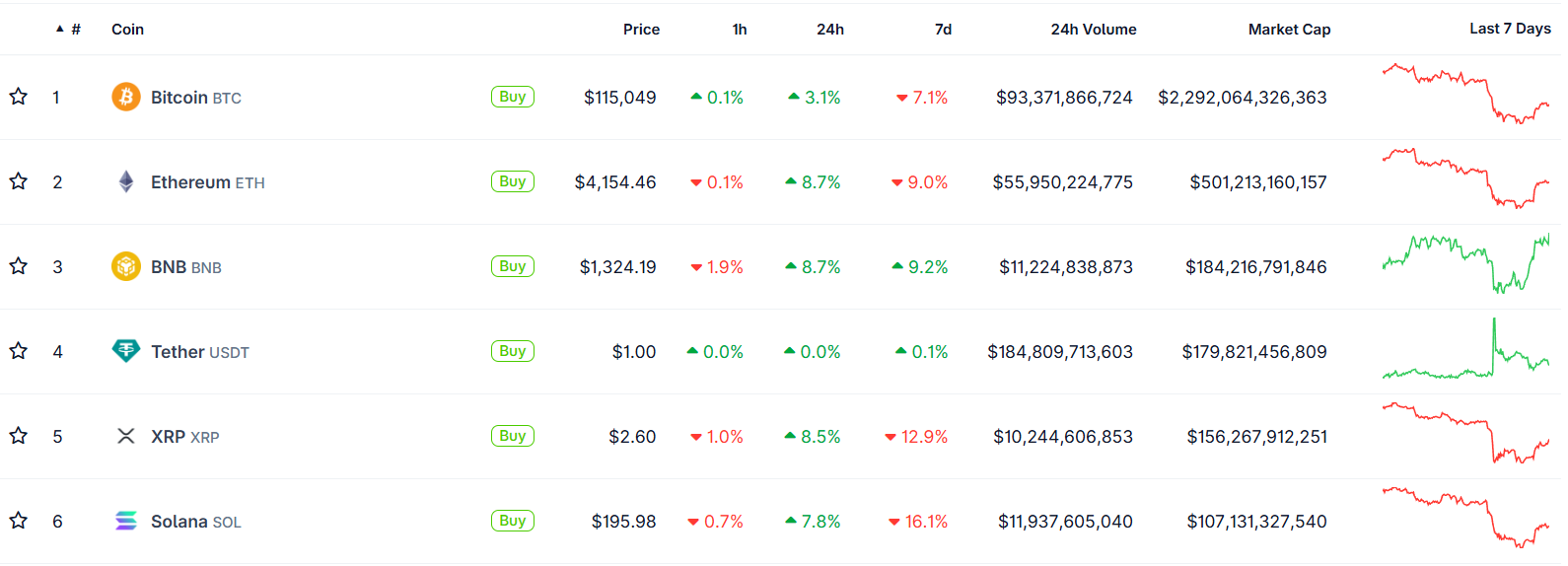
One narrative gaining traction is that this crash was not a structural breakdown but a “relief rally”, a market reset after overleveraged participants were squeezed out of positions. Analysts highlight that sell pressure has eased, sentiment is stabilizing, and capital is re-entering the market, all signs that the broader uptrend may still be intact.
“What we just saw was a massive emotional reset,” Head of Partnerships at Arctic Digital Justin d’Anethan said.

“I would have another, more positive take: seeing 10B worth of liquidation happen in a flash and pushing BTC prices down 15%+ in less than 24hrs to then see BTC recoup 10% to 110K is a testament to how far we've come and how massive and important BTC has become,” he posted on 𝕏.
Moreover, an important datapoint stands out. Exchange inflows to BTC have shrunk, signaling that fewer holders are moving coins to exchanges for sale. This signals that fewer investors are transferring their Bitcoin from personal wallets to exchanges, which is a common precursor to selling. In layman terms, coins are being held rather than prepared for trade.
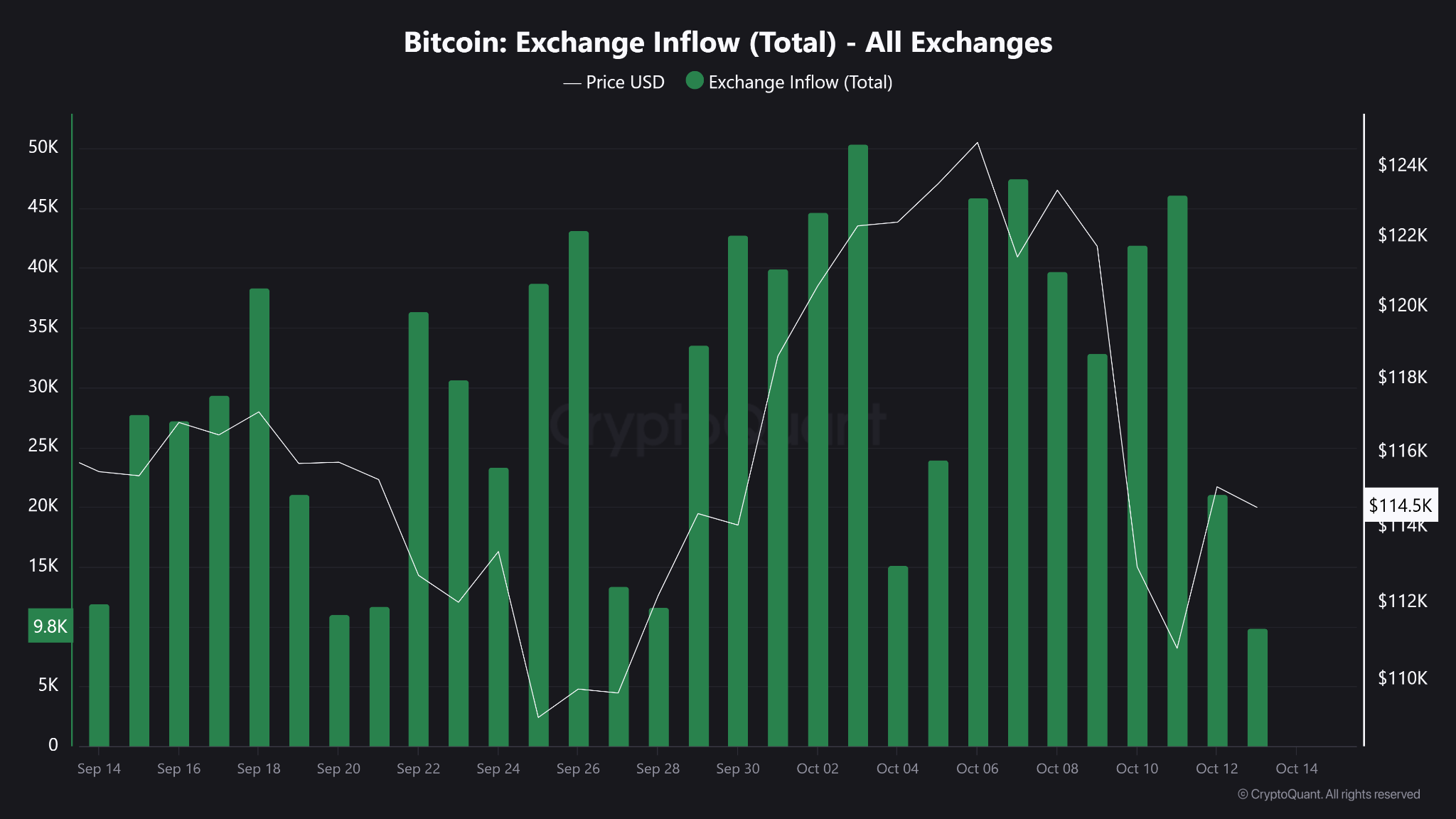
Bitcoin’s Backbone: Resilience Under Pressure
Bitcoin’s ability to rebound after extreme volatility has long been one of its defining traits. Friday’s drop admittedly sent shockwaves through the market, triggering billions in liquidations and exposing the fragility of leveraged trading.
Yet, as history has shown, such sharp pullbacks are far from new for the world’s largest cryptocurrency. In its short history, Bitcoin has endured dozens of drawdowns exceeding 10% in a single day (from the infamous “COVID crash” of 2020 to the FTX collapse in 2022) only to recover and set new highs months later.
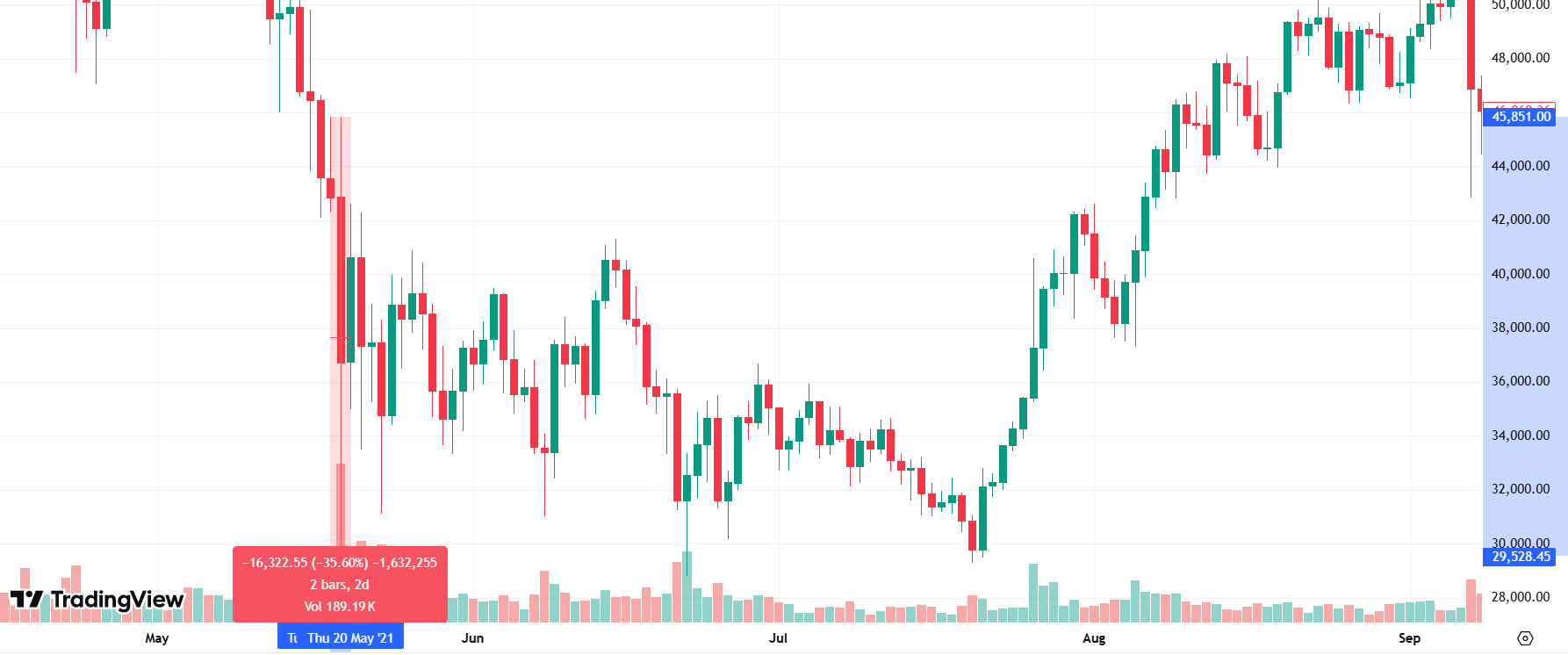
This latest event, while painful, highlights a maturing market structure. Since the approval of spot Bitcoin ETFs in early 2024, institutional involvement has deepened, creating greater liquidity buffers and stronger institutional confidence. Even as billions in leveraged positions were wiped out, Bitcoin has held firm around the $110,000 zone, a level that has since acted as psychological support.
What to Watch Next
The key question now is whether this rebound marks a short-term relief rally or the start of a renewed uptrend. Analysts are closely watching derivatives funding rates, on-chain flows, and ETF inflows for clues. A sustained increase in ETF demand could provide a steady bid under the market, offsetting the effects of future liquidation cascades. Meanwhile, Bitcoin’s ability to hold above $110,000 (an area of heavy trading volume) may serve as confirmation that investor confidence remains intact.
As the market digests the events of October 10, one lesson stands out. Bitcoin’s recovery isn’t just a matter of luck, it’s a reflection of underlying market structure that can absorb shocks. It is built on a growing base of long-term holders, institutional adoption, and a financial system increasingly intertwined with digital assets. Corrections, however dramatic, are not signs of weakness; they are reminders of a maturing market that is striding towards equilibrium.
Bottom Line
The crash on October 10 was brutal, there’s no denying that. It was one of the deepest and fastest in recent memory. But the recovery has been equally sharp. Rather than exposing faults, the rebound has underscored the market’s adaptability and Bitcoin’s central role.
The market consensus is seemingly leaning towards a reset; not a reversal. The shakeout purged excess leverage, and the comeback underlined demand. If Bitcoin can maintain that strength, and the broader market keeps its footing in the coming days, this could mark a turning point rather than a cave-in.
.webp)
Vous avez sûrement déjà entendu parler de ChatGPT – cet assistant IA qui revient dans toutes les conversations autour de la productivité et de la technologie. Et honnêtement ? Il est à la hauteur de sa réputation.
Imaginez un ami très intelligent, disponible à tout moment : que ce soit pour vous aider sur un projet de travail, rédiger un e-mail, ou satisfaire une curiosité soudaine à 23h.
Mais voilà ce qu’on ne vous dit pas toujours au départ : toutes les formules de ChatGPT ne se valent pas. Il y a une vraie différence entre la version gratuite (pratique mais parfois limitée) et les formules payantes (plus rapides, plus puissantes, plus stables).
Que vous soyez étudiant au budget serré ou professionnel à la recherche d’un vrai outil de productivité, comprendre ces différentes formules peut vous aider à choisir celle qui correspond à vos besoins.
Les formules ChatGPT en détail (2025)
Décryptons ce que chaque plan propose, et ce que vous obtenez réellement.
| Plan | Monthly Cost | Annual Cost | Best For |
|---|---|---|---|
| Free | $0 | $0 | Casual users, testing |
| Plus | $20 | $20 | Individual professionals |
| Team | $30/user | $25/user | Small teams, startups |
| Pro | $200/user | $200/user | Power users, researchers |
| Enterprise | ~$60+/user | Custom pricing | Large organisations |
✅ Formule gratuite
Tarif : 0 $
Fonctionnalités :
- Accès à GPT-4o mini
- Accès limité à GPT-4o
- Mode vocal standard
- Téléchargement de fichiers
- Génération d’images
- Navigation web
- Analyse avancée de données
Pour qui ?
Parfait pour découvrir l’outil sans engagement. Une bonne façon de tester ce que ChatGPT peut faire, même si certaines fonctions sont limitées.
✅ Formule Plus
Tarif : 20 $ / mois
Fonctionnalités :
- Jusqu’à 80 messages par tranche de 3 heures
- Accès prioritaire à GPT-4o
- Réponses plus rapides
- Mode vocal avancé
- Accès anticipé aux nouvelles fonctionnalités
- Création de GPT personnalisés
Pour qui ?
Idéal pour les indépendants, étudiants ou pros qui utilisent l’IA régulièrement. Cette formule transforme ChatGPT en assistant de travail fiable, disponible et performant.
✅ Formule Team
Tarif : 30 $ / utilisateur / mois ou 25 $ avec engagement annuel
Fonctionnalités :
- Tout ce qui est inclus dans Plus
- Collaboration entre 2 utilisateurs ou plus
- Espace de travail partagé
- Données privées (non utilisées pour l'entraînement)
- Contrôle administrateur et suivi d’utilisation
- GPT personnalisés pour l’équipe
Pour qui ?
Conçue pour les petites équipes ou startups qui veulent travailler ensemble sur des projets IA tout en gardant un cadre sécurisé et organisé.
✅ Formule Pro
Tarif : 200 $ / mois / utilisateur
Fonctionnalités :
- Accès illimité à GPT-4o
- Raisonnement avancé
- Performances de niveau recherche
- Ressources de calcul premium
- Toutes les fonctionnalités précédentes
Pour qui ?
Destinée aux utilisateurs intensifs : chercheurs, développeurs, ingénieurs. Si vous utilisez l’IA comme outil principal au quotidien, cette formule offre un accès sans limites aux capacités les plus avancées.
✅ Formule Enterprise
Tarif : à partir de 60 $ / utilisateur / mois (minimum 150 utilisateurs sur 12 mois)
Fonctionnalités :
- Confidentialité et sécurité renforcées
- Connexions avec les outils internes (Drive, SharePoint, GitHub…)
- Déploiement sur mesure
- Contrôles d’accès avancés
- Support dédié
- Limites personnalisées
Pour qui ?
Pensée pour les grandes entreprises qui souhaitent intégrer l’IA à leur infrastructure tout en respectant les standards de conformité et de sécurité.
Quelle formule choisir ?
Choisir une formule, c’est un peu comme choisir un forfait mobile : vous voulez les bonnes options, sans payer pour ce dont vous n’avez pas besoin.
- Étudiants
Commencez avec la version gratuite. Elle suffit pour la recherche, l’aide à la rédaction, ou les révisions. Si vous constatez des limites fréquentes, la formule Plus peut offrir plus de fluidité pendant les périodes chargées. - Freelances et pros en solo
La formule Plus (20 $/mois) est souvent le meilleur compromis. Que vous soyez créateur de contenu, consultant ou entrepreneur, vous avez accès à des fonctionnalités stables et performantes. - Développeurs et profils techniques
Plus fonctionne pour un usage ponctuel. Pour les projets intensifs ou la génération de code à grande échelle, la formule Pro permet de travailler sans interruption. - Petites équipes et startups
Team (25-30 $/utilisateur) apporte un vrai cadre de travail collaboratif avec la sécurité en prime. Idéal pour les équipes de 2 à 10 personnes. - Grandes entreprises
Enterprise, avec son déploiement personnalisé, permet une intégration complète de l’IA dans les process métiers tout en respectant les exigences internes.
Points à connaître : limites et coûts cachés
Avant de vous lancer, quelques éléments importants à garder en tête :
✅ Usage de l’API
Si vous créez des applis qui utilisent l’API de ChatGPT, le tarif est indépendant des plans ci-dessus. Il est calculé par jeton (par ex. GPT-4 : 0,012 $/jetons de prompt, 0,024 $/jetons de réponse), auxquels s’ajoutent souvent des coûts de serveur ou d’optimisation.
✅ Limitations de messages
Même les formules payantes ont des plafonds. La version gratuite est assez limitée. La formule Plus élargit ces capacités mais n’est pas illimitée. Si vous êtes un utilisateur très actif, ces limites peuvent se faire sentir.
✅ Accès différé à certaines fonctionnalités
Les nouveautés arrivent d’abord pour les abonnés Plus, Pro ou Enterprise. Les utilisateurs de la version gratuite doivent parfois attendre plusieurs mois.
✅ Restrictions sur les fichiers
Même si les uploads sont autorisés, la taille et la complexité des fichiers peuvent poser problème selon les cas d’usage.
Et les alternatives à ChatGPT ?
ChatGPT est top, mais ce n’est pas le seul dans la course. Voici quelques alternatives intéressantes :
- Claude AI (Anthropic)
Tarifs : version gratuite + Pro à 20 $/mois
Atouts : très bon pour l’analyse, longues fenêtres de contexte
Idéal pour : ceux qui travaillent sur des documents longs ou complexes - Perplexity AI
Tarifs : gratuit + Pro à 20 $/mois
Atouts : recherches web intégrées, sources citées
Idéal pour : utilisateurs orientés recherche et vérification de sources - DeepSeek
Tarifs : version gratuite + plans individuels (20–50 $/mois) et offres pro sur devis
Atouts : bonnes performances à coût réduit
Idéal pour : ceux qui veulent une alternative solide à prix modéré - Google Gemini
Tarifs : version gratuite + AI Premium via Google One (20 $/mois)
Atouts : intégration poussée à l’écosystème Google
Idéal pour : utilisateurs déjà investis dans les outils Google
Conclusion : ChatGPT vaut-il son prix en 2025 ?
Tout dépend de l’usage que vous en faites.
- Si vous l’utilisez occasionnellement, la version gratuite est déjà très capable.
- Si vous y revenez chaque jour pour le travail, la formule Plus à 20 $ est vite rentabilisée.
- Pour les équipes, les offres Team et Enterprise permettent de structurer les usages et de professionnaliser les outils.
Bonne nouvelle : vous n’avez pas besoin de tout décider aujourd’hui. Essayez les versions gratuites de ChatGPT, Claude ou Perplexity, et voyez celle qui colle le mieux à votre style de travail. Ensuite, passez à la vitesse supérieure quand vous êtes prêt.
L’intelligence artificielle devient peu à peu aussi essentielle que l’e-mail ou Google Docs. La question n’est plus “si” vous allez l’utiliser, mais “comment” et “avec quoi”.

Le slippage peut faire toute la différence dans vos résultats de trading. Il représente l’écart entre le prix que vous pensiez payer et le prix réel au moment de l’exécution d’un ordre. Voici tout ce que vous devez savoir pour comprendre ce phénomène, gérer le risque et l’éviter autant que possible.
C’est quoi le slippage en crypto ?
Le slippage se produit lorsqu’un ordre d’achat ou de vente est exécuté à un prix différent de celui initialement affiché, en raison de mouvements du marché entre le moment où l’ordre est passé et celui où il est exécuté.
Pourquoi le slippage se produit-il ?
Deux grands facteurs sont à l’origine du slippage : la volatilité et la liquidité.
- Volatilité : Les marchés crypto sont connus pour leurs mouvements de prix rapides. Cela signifie que le prix peut changer entre le moment où vous validez un ordre et son exécution.
- Liquidité : Si une crypto est peu échangée, l’écart entre l’offre et la demande est plus large, ce qui peut entraîner un prix d’exécution bien moins avantageux. Cela arrive souvent sur les altcoins peu liquides, et encore plus fréquemment sur les DEX (échanges décentralisés).
Slippage positif vs. slippage négatif
- Slippage positif : L’ordre est exécuté à un prix plus avantageux que prévu. Par exemple, vous achetez moins cher ou vous vendez plus cher.
- Slippage négatif : L’ordre est exécuté à un prix moins favorable. Cela peut sérieusement impacter votre rentabilité si cela se répète souvent.
Peut-on éviter le slippage ?
On ne peut pas l’éliminer totalement, mais voici quelques techniques pour le limiter :
1. Utiliser des ordres limités
Contrairement aux ordres au marché, les ordres limités vous permettent de fixer un prix maximum (ou minimum) pour l’achat ou la vente. L’ordre ne sera exécuté que si ce prix est atteint.
2. Définir un taux de slippage
Certains échanges permettent de fixer une tolérance de slippage (ex. 0,1 % à 5 %). Cela empêche l’ordre de passer si le prix varie trop. Attention toutefois à ne pas fixer un seuil trop bas, sinon l’ordre pourrait ne jamais être exécuté.
3. Comprendre la volatilité d’un token
Plus vous en savez, mieux vous tradez. Renseignez-vous sur les mouvements passés du token, et sur la volatilité de la plateforme utilisée. Cela vous aidera à prendre des décisions plus éclairées.
Comment calculer le slippage ?
Le slippage peut être exprimé en valeur absolue (en euros ou dollars) ou en pourcentage.
- Montant du slippage : Prix réel - Prix attendu
- Pourcentage : (Montant du slippage ÷ Différence entre prix attendu et prix limite) × 100
Exemple : Vous voulez acheter du Bitcoin à 50 000 $, avec un ordre limite à 50 500 $. Finalement, l’ordre est exécuté à 50 250 $.
- Slippage = 250 $
- Pourcentage = (250 ÷ 500) × 100 = 50 %
Dans cet exemple, votre slippage est de 250 $ ou 50 %.
Vous voulez en savoir plus sur les crypto-monnaies et le trading ? Consultez tous nos autres articles éducatifs ici.
.png)
Que vous soyez fidèle à votre écran d’ordinateur ou adepte du smartphone, vous vous êtes sûrement déjà demandé comment insérer le symbole de la livre sterling (£) dans un document, un email ou un message. Ne cherchez plus — ce guide pratique vous montre comment taper rapidement le symbole £ sur Mac, PC ou mobile.
💡 Et si vous devez envoyer des livres sterling à l’étranger, Tap vous permet de transférer des fonds facilement avec des frais réduits et un excellent taux de change. Envoyez, dépensez ou échangez des GBP ou EUR depuis l’app, partout dans le monde — et gratuitement entre utilisateurs Tap.
D’où vient le symbole de la livre sterling ?
La livre sterling (GBP), symbolisée par £, possède une histoire riche de plus de 1 200 ans. À l’origine, elle représentait un poids d’argent dans l’Angleterre anglo-saxonne. Elle est devenue monnaie officielle en 1694 sous le règne de Guillaume III.
Avec l’expansion de l’Empire britannique, la livre a gagné une importance mondiale. Même après des événements majeurs comme les guerres, la dévaluation de 1967 ou encore le Brexit, elle reste une devise clé de l’économie mondiale.
Selon la Banque d’Angleterre, le symbole £ vient de la lettre L, initiale du mot latin libra, qui signifiait « une livre de monnaie ». L’ajout de la barre horizontale (le trait du £) remonte au moins à 1660, sur un ancien chèque conservé par la banque.
📌 En anglais, le symbole £ est toujours placé avant le montant : par exemple, £10 signifie dix livres. Petite anecdote : en 1970, un billet de £20 représentant William Shakespeare a été émis — une tradition est née, celle d’honorer des figures emblématiques sur les billets et pièces.
Comment insérer le symbole £ dans un document ?
Maintenant que vous connaissez son origine, voyons comment taper le symbole £ selon l’appareil que vous utilisez.
Sur Mac
Le raccourci le plus rapide est :Option (ou Alt sur certains claviers) + 3
Cette combinaison fonctionne sur les claviers européens. Si vous avez un clavier américain, vous devrez peut-être ajuster votre configuration régionale pour activer les symboles monétaires européens.
Sur Windows
Sur la plupart des claviers Windows, utilisez simplement :Alt + 0163 (en utilisant le pavé numérique)
Ou, si vous avez un clavier britannique :Maj + 3 vous donnera directement le symbole £, souvent visible juste au-dessus du chiffre.
💡 Vous pouvez aussi copier-coller ce symbole directement ici : £
Sur smartphone (iOS ou Android)
Sur votre clavier mobile, appuyez sur le bouton ?123 ou symbole, puis cherchez le £ dans les options.
Si vous ne le voyez pas immédiatement :
- Maintenez le doigt appuyé sur le symbole $ (dollar)
- D’autres symboles monétaires apparaîtront, dont £
Sans clavier ? Aucun souci
Si vous utilisez Microsoft Word ou Google Docs, vous pouvez insérer le symbole sans taper quoi que ce soit.
Voici comment faire :
- Dans Word, cliquez sur Insertion > Symbole > recherchez £
- Dans Google Docs, allez dans Insertion > Caractères spéciaux > puis sélectionnez la catégorie Monnaie
Cliquez sur le symbole £ pour l’insérer dans votre texte.
Et voilà !
Vous savez désormais comment insérer le symbole £ facilement, que vous soyez sur ordinateur ou sur téléphone. Que ce soit pour un mail professionnel, une facture ou un post sur les réseaux, vous êtes prêt·e à taper £ en toute simplicité
.

Vous connaissez peut-être déjà l’achat et la vente de cryptomonnaies, mais avez-vous déjà entendu parler des airdrops ? Ces distributions gratuites de tokens sont en réalité des stratégies marketing visant à faire connaître un projet blockchain. Elles permettent de toucher une large audience et de créer de l’engagement. Explorons ensemble comment fonctionnent les airdrops et ce qu’ils peuvent réellement apporter.
Qu’est-ce qu’un airdrop crypto ?
Un airdrop crypto, c’est lorsqu’un projet distribue gratuitement ses tokens natifs à des utilisateurs — souvent pour attirer l’attention, élargir sa communauté ou encourager l’adoption. En clair : de la crypto gratuite, parfois en échange d’une petite action (suivre un compte, s’inscrire à une newsletter), parfois sans rien faire du tout.
Les tokens sont transférés dans les portefeuilles des utilisateurs existants ou potentiels. Cette technique a explosé lors du boom des ICOs en 2017, et reste encore largement utilisée. Même si ces tokens sont donnés gratuitement, leur valeur peut augmenter avec le temps — ce qui les rend parfois très intéressants pour les détenteurs.
C’est aussi une méthode pour augmenter le nombre de portefeuilles actifs (un bon indicateur pour les nouveaux projets) et favoriser la décentralisation en élargissant la détention des tokens.
Comment fonctionne un airdrop crypto ?
Les airdrops sont souvent planifiés dans la feuille de route d’un projet et se déclenchent après avoir atteint certains objectifs. Les modalités varient, mais en général, de petites quantités de tokens (souvent sur Ethereum ou une autre blockchain compatible avec les smart contracts) sont envoyées à plusieurs portefeuilles.
Certains airdrops sont entièrement gratuits, d’autres demandent de remplir quelques conditions : s’abonner à un canal Telegram, relayer un post sur X, ou simplement détenir un certain nombre de tokens.
Un airdrop bien pensé génère souvent du bouche-à-oreille autour du projet avant même sa cotation sur un exchange.
Quelle est la différence entre un ICO et un airdrop ?
Même s’ils sont tous deux liés au lancement de nouveaux projets crypto, la différence est claire :
- Un ICO (Initial Coin Offering) demande aux participants d’acheter des tokens, généralement pour lever des fonds.
- Un airdrop, lui, consiste à distribuer gratuitement des tokens, sans engagement financier.
Les ICO sont donc des moyens de financement, tandis que les airdrops sont des outils marketing.
Quels sont les différents types d’airdrops ?
Il existe plusieurs formes d’airdrops. Voici les plus courants :
Airdrops exclusifs
Réservés aux utilisateurs précoces ou aux membres actifs de la communauté, ces airdrops récompensent la fidélité. Exemple célèbre : Uniswap, qui a distribué 400 UNI à chaque portefeuille ayant interagi avec la plateforme avant une certaine date. Ces tokens de gouvernance donnaient un droit de vote sur les décisions du projet.
Airdrops “bounty”
Ces airdrops exigent une participation active : suivre des comptes, partager des contenus, inviter des amis, etc. Le projet peut demander une preuve d’engagement avant de distribuer les tokens.
Airdrops pour détenteurs (holders)
Ici, seuls les portefeuilles détenant déjà des tokens du projet sont récompensés. Le projet effectue une capture d’écran (snapshot) des soldes à un moment donné, et distribue des tokens aux portefeuilles éligibles.
Certains projets utilisent aussi des airdrops pour attirer des utilisateurs d’autres blockchains. En 2016, par exemple, Stellar (XLM) a distribué 3 milliards de XLM aux détenteurs de Bitcoin, dans l’idée d’élargir sa base d’utilisateurs.
Les risques liés aux airdrops
Comme souvent dans l’univers crypto, tout n’est pas toujours rose. Les airdrops attirent aussi des acteurs malveillants.
Exemples de scams courants :
- Vous recevez des tokens inconnus dans votre portefeuille. En les bougeant, votre portefeuille est vidé.
- Un faux projet vous incite à connecter votre wallet à une plateforme frauduleuse. Résultat : vos données privées sont récupérées.
⚠️ Un airdrop légitime ne vous demandera jamais de payer quoi que ce soit, ni de fournir votre seed phrase ou clé privée. Restez toujours vigilant et faites vos propres recherches (DYOR).
Autre point à surveiller :
Un airdrop massif peut fausser la perception de la popularité d’un projet. Si un token est envoyé à des milliers de wallets mais n’est quasiment jamais échangé, attention au miroir aux alouettes. Assurez-vous que le volume de trading réel correspond au nombre d’utilisateurs actifs.
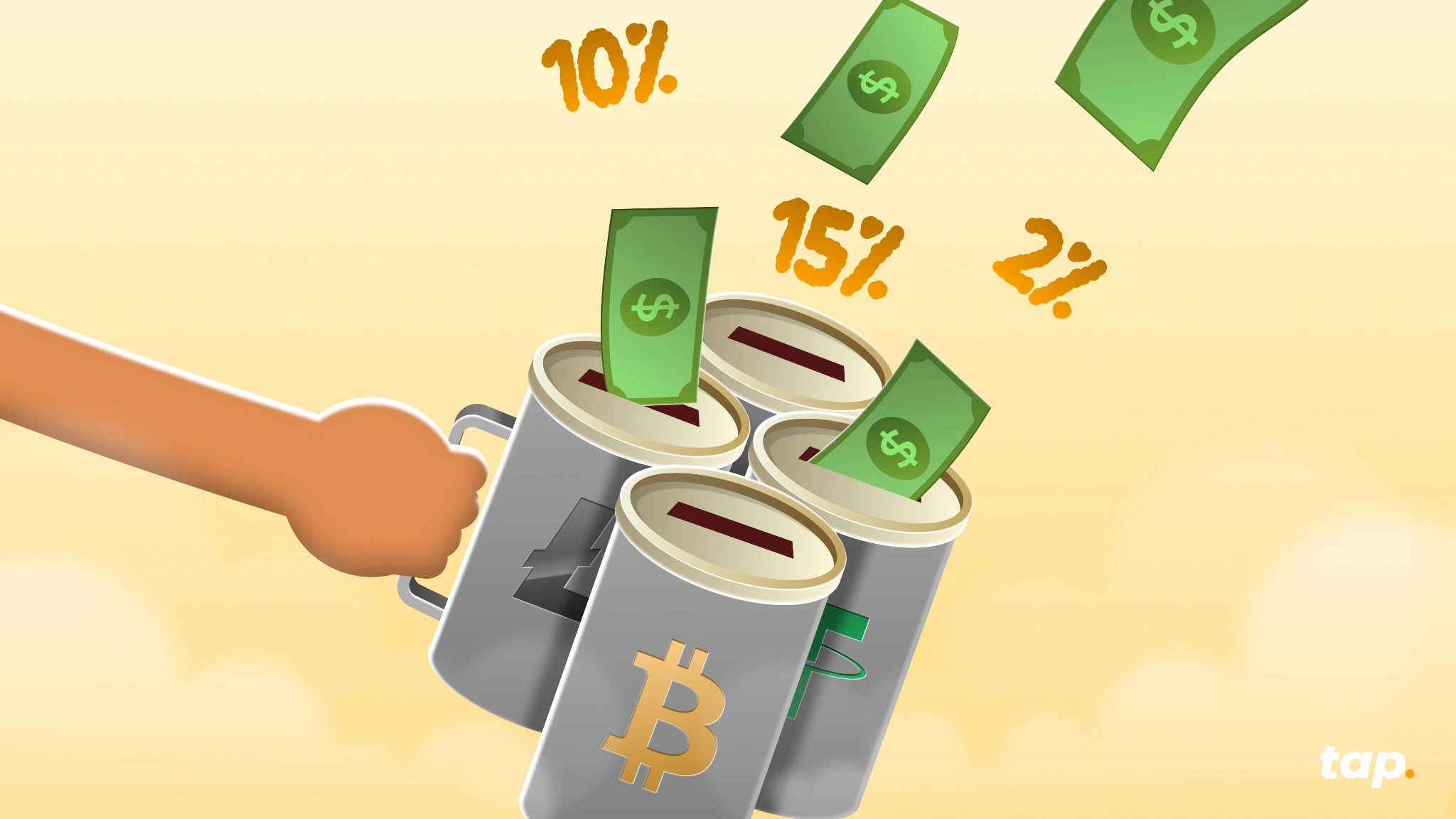
Let's Talk About Getting Your Crypto to Work While You Sleep
Remember when your grandparents bragged about their 2% savings account? Those days feel like ancient history now that crypto APY percentages are floating around that would make a traditional banker faint. But hold up, before you start dreaming about retiring next month on those sweet, sweet yields, let's dive into what APY actually means and why some of these numbers look like lottery tickets.
What the Is APY, Anyway?
Think of APY as compound interest on steroids. While your bank's savings account sits there earning dust, APY measures how much your money can actually grow in a year when interest keeps building on top of interest. The faucet of passive income is now open.
Here's a reality check: Park $1,000 in your bank at 5% simple interest, and you'll have a whopping $1,050 after a year. Yawn, boring… But that same money with 5% APY compounded monthly? You're looking at $1,051.16.
"Big deal, that's only a dollar!" you might say. But here's where it gets interesting. Over time, that compounding effect turns into a money snowball rolling down a mountain. The difference between simple interest and compound interest isn't just pennies; it's the difference between walking and taking a rocket ship.
APY vs. APR: The Sibling Rivalry You Need to Understand
Okay, confession time…even seasoned crypto folks mix these up. Here's your cheat sheet:
APY (Annual Percentage Yield): What you earn when you lend out your crypto. The higher, the better for your wallet.
APR (Annual Percentage Rate): What you pay when you borrow crypto. Lower is your friend here.
Think of it this way: APY is the cool cousin who brings you money, while APR is the one who always asks to borrow twenty bucks.
For a more detailed comparison, click here.
Where Does APY Show Up in Crypto?
- Crypto "Savings Accounts"
Some platforms let you deposit your tokens and watch them multiply. It's like putting your crypto to work at a job that actually pays decent wages. Your coins get lent out to traders who need them, and you get a cut of the action.
- Staking: Become a Network Validator
With Proof-of-Stake blockchains like Ethereum or Cardano, you can "stake" your tokens to help secure the network. Think of it as being a digital security guard who gets paid in crypto. The network stays safe, and you earn rewards. Win-win.
- Yield Farming: The Wild West of DeFi
This is where things get interesting, and a bit crazy. You provide liquidity to decentralized exchanges, and in return, you earn trading fees plus shiny new governance tokens. Early yield farmers sometimes see APYs that look like phone numbers, but don't get too excited; those rates have a habit of crashing back to earth.
- Lending Protocols: Become the Bank
Platforms like Aave and Compound let you play banker. You lend your tokens, borrowers pay interest, and you collect the proceeds. APY goes up when everyone wants to borrow your particular flavor of crypto, and down when the demand cools off.
Why Are Crypto APYs So High?
While your bank offers you a measly 0.5%, crypto platforms are throwing around eye-watering numbers like 10%, 50%, or even 1,000%+. Here's why:
Crypto traders will pay premium rates to short a token or execute complex arbitrage strategies. Supply and demand at its finest.
Hype for new projects also plays a role. Fresh projects often throw ridiculous APYs at users to attract liquidity. It's like a grand opening sale, but with more zeros.
Risk gets factored in. Let's be real, crypto can get risky at times. Higher returns compensate for the white-knuckle ride.
Finally, token Incentives can play a role too. Many of those eye-popping APYs come partially from project tokens that could moon... or crater. It's the crypto Russian roulette.
The Math Behind the Magic
Don't worry, we're not about to turn this into a calculus nightmare. The APY formula is actually pretty straightforward:
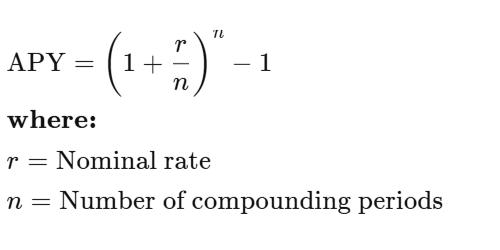
Example: 10% interest compounded monthly gives you about 10.47% APY. Compound it daily? You're looking at 10.52%. In crypto, some protocols compound every block, which is like compounding every few seconds. Your calculator might start smoking.
The Fine Print
Before you quit your day job and become a full-time yield farmer, let's talk about the risks that nobody likes to mention at crypto parties. First up is volatility. Sure, your APY might be 20%, but if your token's price drops 50%, you're still in the red. Math is cruel like that. Then there's impermanent loss, which sounds harmless but can eat into your gains faster than you can say "automated market maker" when you're providing liquidity and token prices start dancing around.
Don't forget about smart contract risk, either. DeFi protocols are basically computer programs holding billions of dollars, and if they break, funds can disappear into the digital ether without so much as a goodbye note. Platform risk is equally sobering. Remember Celsius? FTX? Sometimes the platforms themselves go belly-up, taking user funds with them like the Titanic.
Last but not least, there’s APY whiplash. That jaw-dropping 100% APY you bookmarked yesterday? It might be 15% today because crypto moves fast. Rates fluctuate based on demand, new competition, token economics, and sometimes just because the crypto gods felt like shaking things up.
What's a "Good" APY?
- Conservative. Sticking to blue-chip assets and reputable platforms for 3-8% APY. For the faint of heart.
- Moderate. Staking some altcoins or providing liquidity for 10-20% APY. There’s some excitement, but not heart-attack levels.
- High (YOLO). Chasing new DeFi projects for 50-100%+ APY. It’s worth keeping in mind there’s a non-zero chance your tokens might become expensive digital art.
Remember, if an APY looks too good to be true, it's probably attached to risks that would make a hedge fund manager nervous.
Crystal Ball Time: The Future of APY in Crypto
Here's where things get interesting. As crypto grows up, APYs are starting to act less like lottery tickets and more like actual financial products. Big institutions are getting into staking, regulators are paying attention, and the wild west is slowly becoming a proper town with actual roads.
It’s likely crypto will keep offering better yields than traditional finance. It's just that the 10,000% APY days are likely becoming a fond memory.
The Bottom Line
APY in crypto is the same mathematical concept your finance professor taught you, just dressed up in digital clothing and offering significantly better rates. Whether you're staking, lending, or yield farming, understanding APY helps you separate the wheat from the chaff and the legitimate opportunities from dubious schemes.
APY isn't a cheat code to infinite money. It's a tool that, when used wisely, can help your crypto actually work for you instead of just sitting in your wallet looking pretty. But like everything in crypto, it comes with risks that deserve respect and careful consideration.
It’s worth remembering the best APY in the world is worthless if the underlying project disappears into the digital sunset. Choose wisely, diversify smartly, and may your compounds be ever in your favor.
TAP'S NEWS AND UPDATES
What’s a Rich Text element?
What’s a Rich Text element?The rich text element allows you to create and format headings, paragraphs, blockquotes, images, and video all in one place instead of having to add and format them individually. Just double-click and easily create content.
The rich text element allows you to create and format headings, paragraphs, blockquotes, images, and video all in one place instead of having to add and format them individually. Just double-click and easily create content.Static and dynamic content editing
Static and dynamic content editingA rich text element can be used with static or dynamic content. For static content, just drop it into any page and begin editing. For dynamic content, add a rich text field to any collection and then connect a rich text element to that field in the settings panel. Voila!
A rich text element can be used with static or dynamic content. For static content, just drop it into any page and begin editing. For dynamic content, add a rich text field to any collection and then connect a rich text element to that field in the settings panel. Voila!How to customize formatting for each rich text
How to customize formatting for each rich textHeadings, paragraphs, blockquotes, figures, images, and figure captions can all be styled after a class is added to the rich text element using the "When inside of" nested selector system.
Headings, paragraphs, blockquotes, figures, images, and figure captions can all be styled after a class is added to the rich text element using the "When inside of" nested selector system.What’s a Rich Text element?
What’s a Rich Text element?The rich text element allows you to create and format headings, paragraphs, blockquotes, images, and video all in one place instead of having to add and format them individually. Just double-click and easily create content.
The rich text element allows you to create and format headings, paragraphs, blockquotes, images, and video all in one place instead of having to add and format them individually. Just double-click and easily create content.Static and dynamic content editing
Static and dynamic content editingA rich text element can be used with static or dynamic content. For static content, just drop it into any page and begin editing. For dynamic content, add a rich text field to any collection and then connect a rich text element to that field in the settings panel. Voila!
A rich text element can be used with static or dynamic content. For static content, just drop it into any page and begin editing. For dynamic content, add a rich text field to any collection and then connect a rich text element to that field in the settings panel. Voila!How to customize formatting for each rich text
How to customize formatting for each rich textHeadings, paragraphs, blockquotes, figures, images, and figure captions can all be styled after a class is added to the rich text element using the "When inside of" nested selector system.
Headings, paragraphs, blockquotes, figures, images, and figure captions can all be styled after a class is added to the rich text element using the "When inside of" nested selector system.What’s a Rich Text element?
What’s a Rich Text element?The rich text element allows you to create and format headings, paragraphs, blockquotes, images, and video all in one place instead of having to add and format them individually. Just double-click and easily create content.
The rich text element allows you to create and format headings, paragraphs, blockquotes, images, and video all in one place instead of having to add and format them individually. Just double-click and easily create content.Static and dynamic content editing
Static and dynamic content editingA rich text element can be used with static or dynamic content. For static content, just drop it into any page and begin editing. For dynamic content, add a rich text field to any collection and then connect a rich text element to that field in the settings panel. Voila!
A rich text element can be used with static or dynamic content. For static content, just drop it into any page and begin editing. For dynamic content, add a rich text field to any collection and then connect a rich text element to that field in the settings panel. Voila!How to customize formatting for each rich text
How to customize formatting for each rich textHeadings, paragraphs, blockquotes, figures, images, and figure captions can all be styled after a class is added to the rich text element using the "When inside of" nested selector system.
Headings, paragraphs, blockquotes, figures, images, and figure captions can all be styled after a class is added to the rich text element using the "When inside of" nested selector system.
Say goodbye to low-balance stress! Auto Top-Up keeps your Tap card always ready, automatically topping up with fiat or crypto. Set it once, and you're good to go!
Read moreWhat’s a Rich Text element?
What’s a Rich Text element?The rich text element allows you to create and format headings, paragraphs, blockquotes, images, and video all in one place instead of having to add and format them individually. Just double-click and easily create content.
The rich text element allows you to create and format headings, paragraphs, blockquotes, images, and video all in one place instead of having to add and format them individually. Just double-click and easily create content.Static and dynamic content editing
Static and dynamic content editingA rich text element can be used with static or dynamic content. For static content, just drop it into any page and begin editing. For dynamic content, add a rich text field to any collection and then connect a rich text element to that field in the settings panel. Voila!
A rich text element can be used with static or dynamic content. For static content, just drop it into any page and begin editing. For dynamic content, add a rich text field to any collection and then connect a rich text element to that field in the settings panel. Voila!How to customize formatting for each rich text
How to customize formatting for each rich textHeadings, paragraphs, blockquotes, figures, images, and figure captions can all be styled after a class is added to the rich text element using the "When inside of" nested selector system.
Headings, paragraphs, blockquotes, figures, images, and figure captions can all be styled after a class is added to the rich text element using the "When inside of" nested selector system.BOOSTEZ VOS FINANCES
Prêt à passer à l’action ? Rejoignez celles et ceux qui prennent une longueur d’avance. Débloquez de nouvelles opportunités et commencez à façonner votre avenir financier.
Commencer







